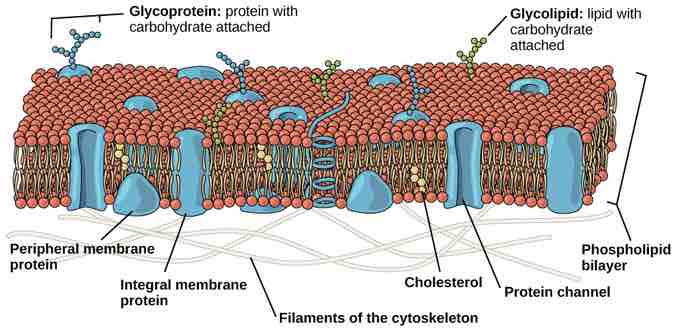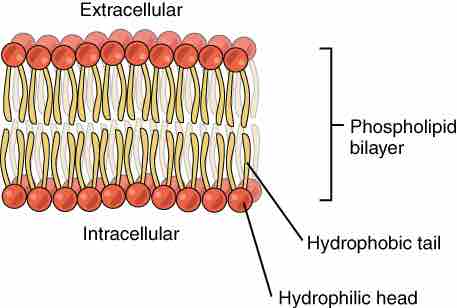The Plasma Membrane
Despite differences in structure and function, all living cells in multicellular organisms have a surrounding plasma membrane (also known as the cell membrane). As the outer layer of your skin separates your body from its environment, the plasma membrane separates the inner contents of a cell from its exterior environment. The plasma membrane can be described as a phospholipid bilayer with embedded proteins that controls the passage of organic molecules, ions, water, and oxygen into and out of the cell. Wastes (such as carbon dioxide and ammonia) also leave the cell by passing through the membrane.

Eukaryotic Plasma Membrane
The eukaryotic plasma membrane is a phospholipid bilayer with proteins and cholesterol embedded in it.
The cell membrane is an extremely pliable structure composed primarily of two adjacent sheets of phospholipids. Cholesterol, also present, contributes to the fluidity of the membrane. A single phospholipid molecule consists of a polar phosphate "head," which is hydrophilic, and a non-polar lipid "tail," which is hydrophobic. Unsaturated fatty acids result in kinks in the hydrophobic tails. The phospholipid bilayer consists of two phospholipids arranged tail to tail. The hydrophobic tails associate with one another, forming the interior of the membrane. The polar heads contact the fluid inside and outside of the cell .

Phospholipid Bilayer
The phospholipid bilayer consists of two adjacent sheets of phospholipids, arranged tail to tail. The hydrophobic tails associate with one another, forming the interior of the membrane. The polar heads contact the fluid inside and outside of the cell.
The plasma membrane's main function is to regulate the concentration of substances inside the cell. These substances include ions such as Ca++, Na+, K+, and Cl–; nutrients including sugars, fatty acids, and amino acids; and waste products, particularly carbon dioxide (CO2), which must leave the cell.
The membrane's lipid bilayer structure provides the cell with access control through permeability. The phospholipids are tightly packed together, while the membrane has a hydrophobic interior. This structure causes the membrane to be selectively permeable. A membrane that has selective permeability allows only substances meeting certain criteria to pass through it unaided. In the case of the plasma membrane, only relatively small, non-polar materials can move through the lipid bilayer (remember, the lipid tails of the membrane are nonpolar). Some examples of these materials are other lipids, oxygen and carbon dioxide gases, and alcohol. However, water-soluble materials—such as glucose, amino acids, and electrolytes—need some assistance to cross the membrane because they are repelled by the hydrophobic tails of the phospholipid bilayer.
Transport Across the Membrane
All substances that move through the membrane do so by one of two general methods, which are categorized based on whether or not energy is required. Passive (non-energy requiring) transport is the movement of substances across the membrane without the expenditure of cellular energy. During this type of transport, materials move by simple diffusion or by facilitated diffusion through the membrane, down their concentration gradient. Water passes through the membrane in a diffusion process called osmosis. Osmosis is the diffusion of water through a semi-permeable membrane down its concentration gradient. It occurs when there is an imbalance of solutes outside of a cell versus inside the cell. The solution that has the higher concentration of solutes is said to be hypertonic and the solution that has the lower concentration of solutes is said to be hypotonic. Water molecules will diffuse out of the hypotonic solution and into the hypertonic solution (unless acted upon by hydrostatic forces).

Osmosis
Osmosis is the diffusion of water through a semipermeable membrane down its concentration gradient. If a membrane is permeable to water, though not to a solute, water will equalize its own concentration by diffusing to the side of lower water concentration (and thus the side of higher solute concentration). In the beaker on the left, the solution on the right side of the membrane is hypertonic.
In contrast to passive transport, active (energy-requiring) transport is the movement of substances across the membrane using energy from adenosine triphosphate (ATP). The energy is expended to assist material movement across the membrane in a direction against their concentration gradient. Active transport may take place with the help of protein pumps or through the use of vesicles. Another form of this type of transport is endocytosis, where a cell envelopes extracellular materials using its cell membrane. The opposite process is known as exocytosis. This is where a cell exports material using vesicular transport.
Cytoplasm
The cell's plasma membrane also helps contain the cell's cytoplasm, which provides a gel-like environment for the cell's organelles. The cytoplasm is the location for most cellular processes, including metabolism, protein folding, and internal transportation.